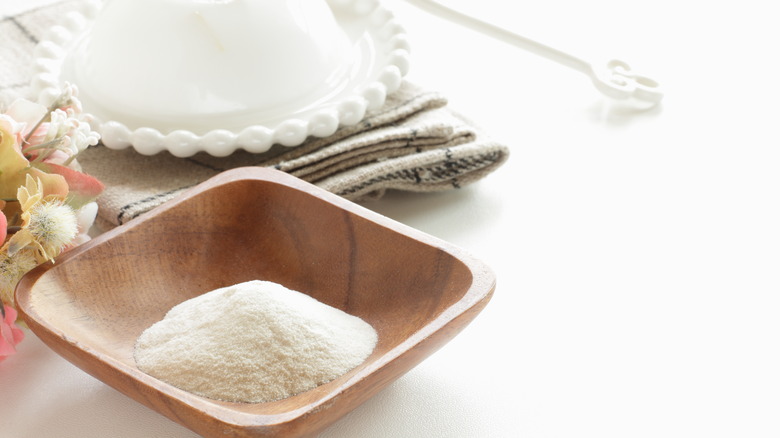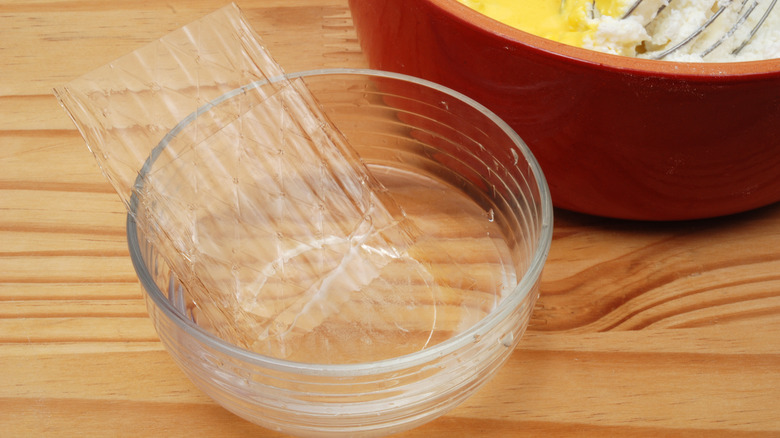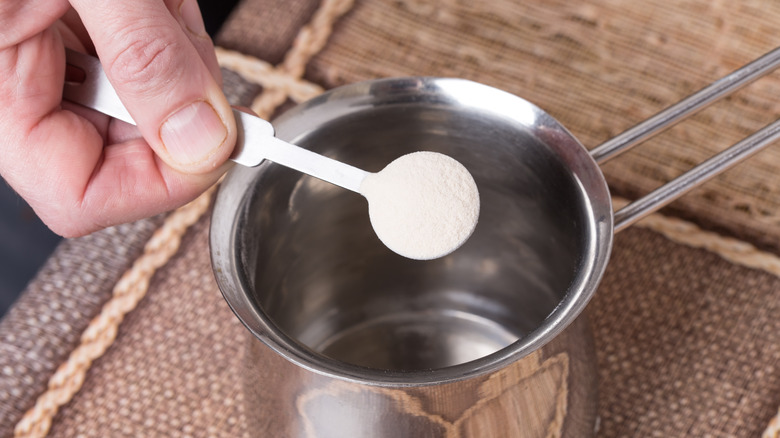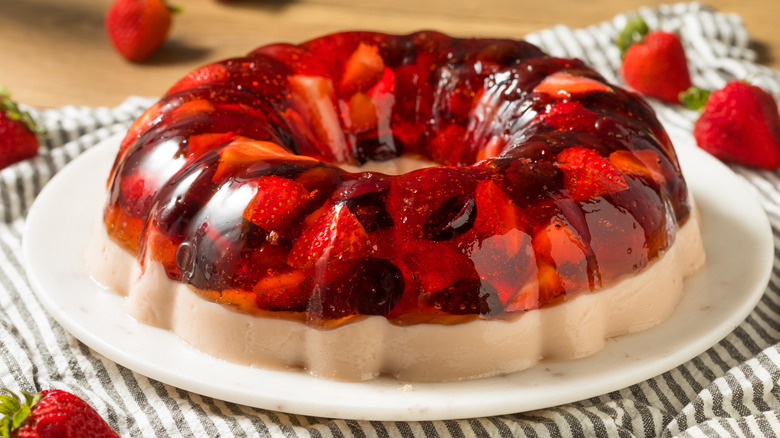The Difference Between Sheet And Powdered Gelatin
What do marshmallows, canned hams, cheese spreads, broths, and some cheesecakes have in common? If you said they were all at your last Thanksgiving table, that's great. But, they also all contain gelatin. According to Medical News Today, gelatin is used in these and a slew of other foods and products as a thickening and gelling agent. To make gelatin, collagen is extracted from animal skin, bones, and tendons and made into the ingredient that makes gummy bears chewy and Jell-O wobbly (per Livestrong.com). If you've ever noticed a bit of stickiness on your lips after eating a broth-based soup or soup dumplings, this is likely the collagen naturally extracted into the broth.
Before you get grossed out, take note that gelatin is completely flavorless and colorless and contains high levels of protein and amino acids (via Medical News Today). Vegetarians and vegans can use substitutions like pectin and agar agar. Gelatin takes two forms when it comes to the culinary world: gelatin sheets (also called leaf gelatin) and gelatin powder. Both forms do the same thing but with subtle differences that make each better for certain dishes.
Gelatin sheets
Gelatin sheets look exactly like how they sound: flat, thin, clear sheets. They need to be soaked in cold water for five to 10 minutes and then squeezed gently or drained of excess water. Afterward, they are ready to be added to and dissolved into whatever warm liquid your recipe calls for. Definitely don't boil the liquid, or the gelatin will not set, per Modernist Pantry. This process is called "blooming" (via Food52).
According to Modernist Pantry, many professional chefs prefer sheet gelatin because it results in a clearer result (no cloudiness, more transparent) with a purer flavor. In addition, they are easy to use, as one simply counts out the number of sheets a recipe calls for as opposed to possibly incorrectly weighing the amount of gelatin powder required. Most European recipes utilize sheet gelatin. Because of its crystal-clear effect, sheet gelatin may be best in recipes such as mirror-glaze cakes (per Food Crumbles), hoity-toity aspics, and the prettiest Jell-O shots you can make!
Gelatin powder
Most American recipes will call for powdered gelatin, likely because it is much easier to find in supermarkets. It is basically the same thing as sheet gelatin, just in powdered form. The upside to this form of gelatin is that the powder dissolves quickly. According to Substitute Cooking, one simply measures out the amount of powder needed and dissolves it into the required cold liquid. After five to 10 minutes, the mixture will swell and look sort of like applesauce (per All Recipes). This process is also called blooming. The gelatin is now hydrated and ready to be combined into a hot liquid for setting. The key to using powder is to ensure it is completely dissolved. If not, you are left with granules as well as an unpleasant taste and texture. Although not super-noticeable, using gelatin powder does tend to leave a slight aftertaste, unlike sheet gelatin.
Powdered gelatin is simple to use because it's easy to measure out. American recipes calling for gelatin will typically instruct exactly how many teaspoons or tablespoons to use, taking any guesswork out of the equation. Sometimes they will specify how many envelopes of gelatin to use, as Knox is a popular brand that packages its powder in pre-measured envelopes. Powdered gelatin is a great option for recipes such as panna cottas and homemade marshmallows.
Is it okay to swap?
Because gelatin sheets and gelatin powder are the same except in form, it is absolutely okay to swap one version for the other. However, it's not as easy as swapping a tablespoon of powder for a sheet of gelatin. There is even some debate on the subject. The experts at Knox claim that 1 pouch (or envelope) of their gelatin equals 5 sheets of powder gelatin. According to The Kitchn, 1 tablespoon of powdered gelatin equals 4 gelatin sheets. You can also measure by weight: use 7 grams of gelatin per 1 cup of liquid to be set (yeah, the tablespoon method sounds easier). The best and easiest choice is to choose a recipe that is well-written (and preferably has good reviews) and carefully follow the instructions.
The more you work with gelatin (sheets or powder), the more you'll understand how it works. You'll feel more comfortable deciphering whether your taste buds crave a little less or a little more of this versatile ingredient.



